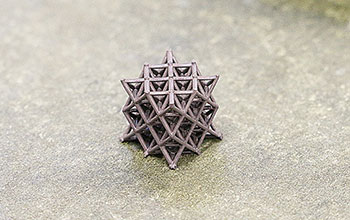Multimedia Gallery
Magnetoactive acoustic metamaterial (Image 2)
A close-up of a new magnetoactive acoustic metamaterial created by researchers from the University of Southern California Viterbi School of Engineering. [Image 2 of 2 related images. Back to Image 1.]
More about this image
A team led by researchers from the University of Southern California (USC) Viterbi School of Engineering has developed 3D-printed acoustic metamaterials that can be switched on and off remotely using a magnetic field.
Researchers have been pushing the capabilities of materials by carefully designing precise structures that exhibit abnormal properties that can control acoustic or optical waves. However, these metamaterials are constructed in fixed geometries, meaning their unique abilities are always fixed. The new 3D printed metamaterial developed by the team are capable of blocking sound waves and mechanical vibrations and unlike current metamaterials, these can be turned on or off remotely using a magnetic field. Their materials can be used for noise cancellation, vibration control and sonic cloaking, which can be used to hide objects from acoustic waves.
"When you fabricate a structure, the geometry cannot be changed, which means the property is fixed. The idea here is, we can design something very flexible so that you can change it using external controls," said Qiming Wang, a USC Viterbi assistant professor of civil and environmental engineering.
Metamaterials can be used to manipulate wave phenomena such as radar, sound and light, and have been used to develop technology such as cloaking devices and improved communication systems. The team's metamaterials can control environmental sounds and structural vibrations, which have similar waveforms. By 3D printing a deformable material containing iron particles in a lattice structure, their metamaterials can be compressed using a magnetic field.
"You can apply an external magnetic force to deform the structure and change the architecture and the geometry inside it. Once you change the architecture, you change the property," Wang said. "We wanted to achieve this kind of freedom to switch between states. Using magnetic fields, the switch is reversible and very rapid."
The magnetic field compresses the material, but unlike a physical contact force like a metal plate, the material is not constrained. Therefore, when an acoustic or mechanical wave contacts the material, it perturbs it, generating the unique properties that block sound waves and mechanical vibrations of certain frequencies from passing through.
This research was funded in part by the National Science Foundation (grant CMMI 16-49093).
Learn more about this research in the NSF News From the Field story 3-D printed active metamaterials for sound and vibration control. (Date image taken: March 2018; date originally posted to NSF Multimedia Gallery: July 20, 2018)
Credit: Photo by Qiming Wang/USC Viterbi School of Engineering
See other images like this on your iPhone or iPad download NSF Science Zone on the Apple App Store.
Images and other media in the National Science Foundation Multimedia Gallery are available for use in print and electronic material by NSF employees, members of the media, university staff, teachers and the general public. All media in the gallery are intended for personal, educational and nonprofit/non-commercial use only.
Images credited to the National Science Foundation, a federal agency, are in the public domain. The images were created by employees of the United States Government as part of their official duties or prepared by contractors as "works for hire" for NSF. You may freely use NSF-credited images and, at your discretion, credit NSF with a "Courtesy: National Science Foundation" notation.
Additional information about general usage can be found in Conditions.
Also Available:
Download the high-resolution JPG version of the image. (5.6 MB)
Use your mouse to right-click (Mac users may need to Ctrl-click) the link above and choose the option that will save the file or target to your computer.

